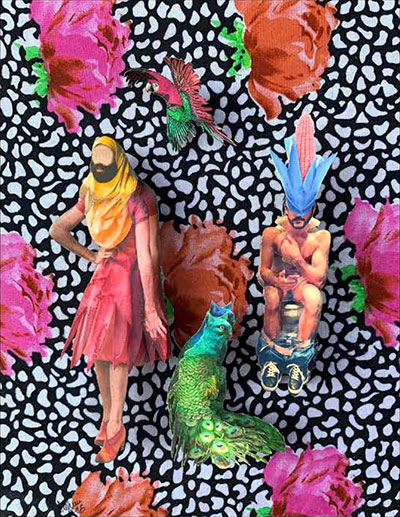Written by: Jovita Alvares
Posted on: June 17, 2019 | 
The Crevasse (L), The Crossing (C), The Hollow (R) by Amna Hashmi
Koel Gallery’s latest exhibition titled, ‘Small is Beautiful’ features the work of seven contemporary Pakistani artists. It is based on a passage from the book of the same name, written by unconventional economist E.F. Schumacher. This exhibition features Alia Bilgrami, Amna Hashmi, Maryam Baniasadi, Mohsin Shafi, Samia Ali, Samar Zia and Zarina Khan.
Written in 1973, Schumacher’s book revolves around the idea that economics should work for the common man, and not the other way around. It is a unique exploration of politics and environmentalism during a time in which globalisation had just begun. For this exhibition, the artists looked specifically at Schumacher’s words which state ‘…monotonous, moronic work is an insult to human nature’, and is met by the ‘unbreakable silence’ of unoriginality.
Inspired by these words, this group of artists created an open dialogue that spoke of various social aspects through their detailed and carefully observed works of art. While addressing Schumacher’s text, the artists also displayed their acute understanding and careful exploration of their respective artistic trainings.
Alia Bilgrami, a Pakistani-Canadian artist, explored the idea of displacement in her pieces. She uniquely uses the tulip as a subject, which can be seen in ‘Life goes on’ and ‘Stormy Tulips’. The Tulip is a flower that finds its roots in Persia and Turkey, but was later made famous in the West during the ‘Tulip Fever’ of the 17th Century. It rose to popularity and quickly became a symbol of high culture in the West, but remained an indigenous symbol in the East.
Much like the Tulip, Bilgrami feels displaced between Pakistan and Canada, countries situated at opposing ends of the global development scale. She uses her pieces to convey that feeling of being scattered like the flower itself.
Maryam Baniasadi, an Iranian artist, also explores foliage in her work. Taking inspiration from a visit to an abandoned textile factory in Serbia, the artist uses collages of found documents and identification cards, and paints on them. Her preservation of the forgotten memories of the space works alongside the prevalence of foliage growing over the decaying structure. Baniasadi relates this perseverance to that of Persian Miniature design, showing how memories can survive, and grow despite the passage of time.
Mohsin Shafi displays a series of collages and mixed media works, in order to explore the idiosyncrasies of everyday life. He uses visual metaphors through animals, birds and foliage hybrids such as ‘“It was a time when the unthinkable became the thinkable and the impossible really happened…”’

In these almost-overlooked stories, Shafi aims to relay the truths of reality through fictitious portrayals. Laden with meaning, his work explores raw emotion, and taps into the depths of human psyche. The viewer is presented with a chance to explore their own thoughts and ideas, while attempting to uncover the meanings behind Shafi’s multi-layered works.
Amna Hashmi is another artist who delves into the realm of digital imagery. As a miniaturist and Japanese manga enthusiast, Hashmi blends both interests in order to provide an entirely unique story for the viewer. Her instant film series draws the viewer in by sheer visual impact, through providing the viewer with an immediate hard copy of the photograph scene. Within the art of instant film, there is no room for digital tweaking, or adjusting before the final product is produced.
Hashmi on the other hand, presents the viewer with a series of instant photographs that seem otherworldly, yet rooted in our understanding of the everyday. In ‘The Crevasse’, a white figure stands near a blimp under construction. This same blimp then seems to warp through the wall in ‘The Hollow’, and flies through the sky in ‘The Palings’ and ‘The Crossing.’ The whole scenario shows how ordinary objects can make a photo extraordinary, and almost absurd.
All the pieces portray a strange amalgamation that is exciting to witness. Each of the seven well-established artists have furthered their craft and traditional training by using them in a uniquely contemporary manner. Every piece and little detail becomes a small window into places that feel both fantastical and familiar. The show is on display at Koel from 9th to 27th July, 2019.
You may also like: